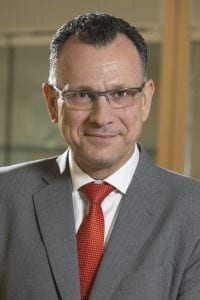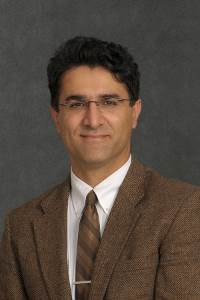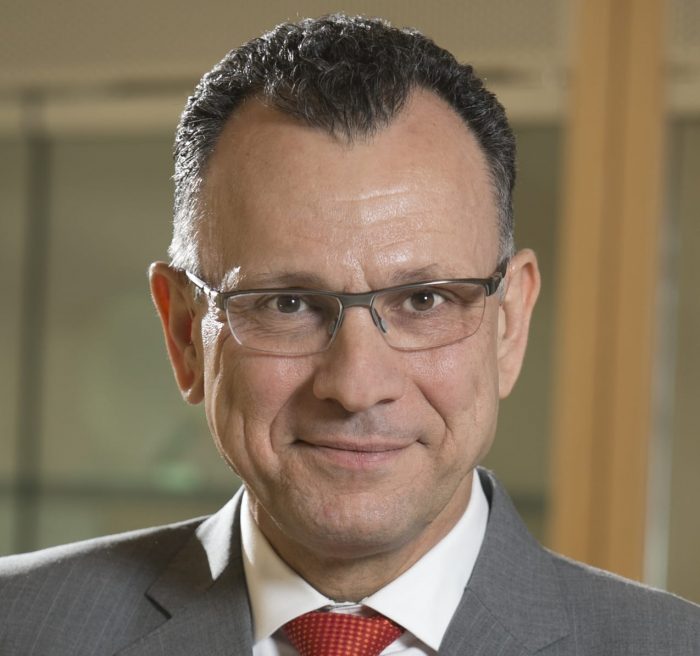SBU scientists receive award for wind farm research
By Daniel Dunaief
Too much of a good thing can be a problem. That’s true even for offshore wind farms.

Using the flow of air to move blades, wind farms convert motion into electricity. The process of gathering energy has numerous costs, including the strain that builds up on the blades, which causes the kind of wear and tear that can reduce the efficiency of the process. The more often companies have to maintain the turbines, the higher the cost of the energy.
Fotis Sotiropoulos, the Dean of the College of Engineering and Applied Sciences and Ali Khosronejad, an assistant professor of Civil Engineering at Stony Brook University, are using computers to reduce the cost and increase the efficiency of these wind farms.
Experts in computer modeling and the flow of everything from water to air to blood through the body, Sotiropoulos and Khosronejad recently received a $1.1 million award from the National Offshore Wind Research and Development Consortium to use computational tools to create the best layout and operations for turbines for offshore wind farms.
By controlling the turbine through computer modeled yawing and/or pitching the blades, the scientists will try to optimize the annual energy production and minimize the structural loads, which reduces the need for maintenance.
“We don’t want too much pressure and turbulence, but at the same time, we want to generate maximum energy from the wind,” explained Khosronejad from Stony Brook University Hospital two days after his second daughter Amytis was born.

Khosronejad and Sotiropoulos, who worked together for seven years at the University of Minnesota before they came separately to Stony Brook, project that the insights that they gain through virtual modeling that uses enormous data streams over large areas of the ocean can reduce the so-called levelized cost of energy (LCOE) by as much as 15 percent.
The LCOE represents the net present cost of electricity generation for an energy plant over its lifetime. Any such reduction in these costs increases available resources for companies like Equinor, a Stavanger, Norway-based leader in offshore wind development that is a partner in this work, to increase the efficiency and effectiveness of generating energy.
Sotiropoulos suggested that virtual models that use high performance supercomputers can enable simulations that can lead to the construction of more efficient and effective wind farms.
“The more you keep cycling and fatiguing [the blades] with high bursts of wind, the more likely you are to develop micro cracks,” which require companies to shut down the facility to repair or replace the blade, Sotiropoulos said.
Companies have developed programs that allow the blades to sense the forces and that can orient or pitch the blades to minimize the loads. “What has never been done before, however, is to incorporate the effect of these control strategies into the design of an entire wind farm,” Sotiropoulos wrote in an email.
The addition of artificial intelligence tools is a new element to previous work. Training artificial intelligence models that use state-of-the-art algorithms will be computationally efficient for optimization studies, he explained.
Over the last 10 years, Sotiropoulos has received over $13 million of the $37 million in total research funding he received for wind and tidal energy. Indeed, when he was at the University of Minnesota, which will serve as a partner on the current project, Sotiropoulos received one of three Department of Energy grants across the nation to build a 2.5 megawatt turbine to conduct research that also provided power.
When he arrived at Stony Brook University as dean, he knew “Long Island had tremendous off shore wind potential,” Sotiropoulos said. Long Island has the only offshore wind farm in the United States, with a 30 megawatt facility off of Block Island.
Indeed, New York State has made considerable investments in wind energy in general and in Stony Brook’s efforts in particular. Early this year, Governor Andrew Cuomo (D) announced an investment of $20 million in a new offshore wind training institute hosted by Stony Brook and SUNY Farmingdale. The institute plans to train 2,500 workers over the next five years.
New York State is moving forward to develop 9,000 megawatts of offshore wind by 2035 and will lead the nation, Sotiropoulos said. “All of that is going to happen around here because of these activities” focused in the area. “The work done here will set the standard for how to develop offshore wind in the rest of the country.”
Specifically, Khosronejad, who joined Stony Brook in September of 2016, described the artificial intelligence that he and Sotiropoulos will use as being similar to the cognitive development of a child. As the scientists add data to their algorithms, the programs begin to learn how any given input can lead to a specific output.
Through parallel supercomputing, they can look at the flow of wind in an area that is 100 miles by 100 miles and that has a height up to one mile above the surface of the water.
“We want to solve for small pockets of air,” Khosronejad said. This can be done with a resolution of about a foot, depending on the availability of CPU on the supercomputing cluster.
On a laptop, that kind of data analysis would take at least 1,000 years to complete. By using supercomputers, they can model the wind flows, which inform their artificial intelligence models, in a week.
The scientists introduce new scenarios that the model didn’t experience during training, which has an error rate that is below one percent.
“It’s a very intelligent system that is affordable to use and that a practitioner can install on their cell phone,” Khosronejad said.
A native of Tehran, Iran, Khosronejad has been in the United States for 12 years. He didn’t speak much English when he arrived and said he took about five years to master it.
Khosronejad and his wife Sanam Ghandehari, who practices family and immigration law, have a 12-year old daughter, Aramis. The family lives in the village of Port Jefferson.
Ghandehari teaches at Touro Law School. Khosronejad described his wife as “incredibly strong” and so smart that he feels intellectually dwarfed when he sits next to her.
As for the next step in their work, Sotiropoulos suggested they would partner with scientists specializing in meso scale weather predictions from the School of Marine and Atmospheric Sciences to look at weather patterns over different parts of the year.
Photos courtesy of SBU







